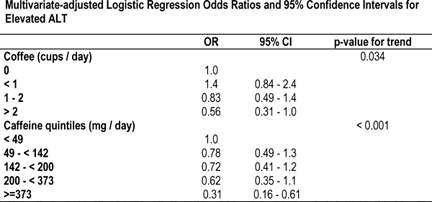 |
 |
 |
| |
Coffee, Caffeine Consumption Associated With Reduced Liver Disease
|
| |
| |
Karla Harby
May 18, 2004 (New Orleans) — A U.S. population study of 5,944 adults conducted by researchers at the National Institute of Diabetes and Digestive and Kidney Diseases (NIDDK) has found a strong association between coffee drinking and caffeine consumption and a lower risk of liver injury in persons at high risk for liver disease.
The researchers defined the high-risk population as those who reported being heavy drinkers of alcohol, or who had hepatitis B or C, iron overload, were obese, or had impaired glucose metabolism. Liver injury was defined as a serum alanine aminotransferase (ALT) activity level in excess of 43 U/L.
The researchers reported that overall, the greater the coffee consumption, the greater the association with liver protection (P = .034 for the trend). The highest consumption noted was more than two cups of coffee per day. Consumers of more than two cups of coffee per day had an odds ratio (OR) for elevated ALT of 0.56 (95% confidence interval [CI], 0.31 - 1.0); those who drank one to two cups had an OR of 0.83 (95% CI, 0.49 - 1.4). Those who drank less than one cup had an odds ratio of 1.4 (95% CI, 0.84 - 2.4), with zero cups being assigned an OR of 1.0.
Because caffeine consumption is so highly associated with coffee drinking in the U.S., it is difficult to untangle the two statistically, explained James E. Everhart, MD, MPH, from the NIDDK, who spoke with reporters here during Digestive Disease Week. Nonetheless, the researchers reviewed consumption of tea and soft drinks containing caffeine, and found a positive association (P < .001 for the trend), with less than 49 mg per day being the lowest threshold.
They found an OR of 0.78 (95% CI. 0.49 - 1.3) for caffeine intake of 49 to 142 mg per day; 0.72 (95% CI, 0.41 - 1.2) for 142 to 200 mg per day; and 0.62 (95% CI, 0.35 - 1.1) for 200 to 373 mg per day. For those who consumed more than 373 mg per day of caffeine, the highest subgroup reported, the OR was 0.31 (95% CI, 0.16 - 0.61).
The mechanisms of action, if any, for coffee and caffeine are completely unknown, Dr. Everhart said. Although coffee has many known effects on the body and has been studied extensively, its specific effects on the liver have been largely unexplored, he added.
The data source was the third U.S. National Health and Nutrition Examination Survey (NHANES III), 1988-1994. The researchers adjusted their analysis for cigarette smoking, age, sex, and ethnicity, and found no change in their results. Dr. Everhart noted that a strength of this general population study is that coffee drinking i such a widespread activity that it seems unlikely that an unknown variable would explain these results.
Lee Kaplan, MD, PhD, from Massachusetts General Hospital in Boston, who moderated the session for reporters, noted that this observational study cannot prove causality or identify the active ingredient in coffee, if any. "These kinds of studies are critical, but it's only a start of the process," he said.
This study was independently funded. The authors report no pertinent financial disclosures. DDW 2004: Abstract M1211. Presented May 16, 2004. Medscape.
Digestive Disease Week program abstract
COFFEE AND CAFFEINE CONSUMPTION PROTECT AGAINST LIVER INJURY IN THE UNITED STATES POPULATION
Authors: Constance E Ruhl, James E Everhart
Background & Aims: The concept that patient behavior may influence the course and severity of chronic liver disease is appealing, but not well investigated. Based on the results of experimental data and epidemiological surveys, we investigated whether coffee drinking and caffeine consumption reduced the risk of liver injury in persons at high risk for liver injury in a national, population-based study.
Methods: 5,944 adult participants in the third U.S. National Health and Nutrition Examination Survey (NHANES III), 1988-1994, who were at high risk for liver injury (due to excessive alcohol consumption, hepatitis B or C, iron overload, obesity, or impaired glucose metabolism) were asked about consumption of caffeine-containing coffee, tea, and soft drinks. Total caffeine from these beverages was calculated and divided into quintiles. Liver injury was indicated by abnormal serum alanine aminotransferase (ALT) activity (> 43 U/L). All analyses incorporated sample weights and the design effects of the survey.
Results: Elevated ALT activity was found in 8.7% of this high risk population. In unadjusted analysis, the prevalence of liver injury declined with both increasing coffee drinking and caffeine consumption. (p<0.05). Multivariate logistic regression analyses adjusting for age, sex, ethnicity, and cigarette smoking, also demonstrated that the risk of liver injury declined with increasing coffee drinking and caffeine consumption, with the protective effect being stronger for caffeine consumption (table). These relationships were consistent across subgroups defined by individual risk factors for liver injury and relatively unchanged when analyses included all NHANES III participants or when limited to persons without impaired liver function and without right upper quadrant pain.
Conclusion: In this large, national, population-based study, among persons at high risk for liver injury, coffee drinking and caffeine consumption from beverages were associated with lower risk of injury. These possible beneficial effects deserve further investigation.
|
|
| |
| |
 |
|
| |
| |
|
| |
|
 |
 |
|
|